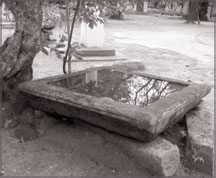Ramba Vihara revisited
by Gamini G. Punchihewa
As a result of the explorations, done by the Ruhuna Central Cultural
Triangle the following archaeological treasures have been conserved.

1. Starting from early 2000, during the tenure of its first
Officer-In-Charge. Gamini Dodanwela, among the noteworthy but rare
relics unearthed and conserved comprised a Ran Karaduwa (a gold plated
Relic casket), and a Ran Kotha (a gold plated pinnacle).
This Karaduwa (relic casket), contain some tiny bone fragments which
Dodanwela conjectured to be those of Sarwangna Datu (of Buddha). Both
the casket and pinnacle had been turned out of clay plated with gold.

Those fragments were in burnt form brown in colour. Dodanwela at the
time I met him for the second time, further enlightened me that these
objects of the Relic casket and the pinnacle together with the bone
fragments had been sent to USA for carbon testing to reckon its period
of time.
At that time he told me that the carbon report relating only to the
relic casket and pinnacle had been received and not those of the bone
fragments. As to the inference of the carbon testing of the relic casket
and pinnacle, it had been testified to belong to the period of 8th and
10th century AD.

At that time Dodanwela, had with him three lively photos of the relic
casket, pinnacle and the bone fragments. He explained in pointing out to
the photographs of their significance. The relic casket contained three
compartments together with the tiny pieces of bones (the size of (gammiris
eta).
These had a lid followed by another such lid. To remove the entire
components, on its top had a copper gold plated lid. Then with another
such lid, it was closed having a small relic chamber.

In its bottom chamber those bone relics in fragments were duly
deposited. When all these objects were not in their pristine state,
while the pinnacle was surmounted over it which were later restored
meticulously to their prime state by the proficient officials attached
to the project.
Plans are also afoot to have a herbarium of medicinal plants endemic
to this region, interlaced with agricultural forests like cocoa, pepper
vines, (gammiris vel), mango jakguwawa (pera) and even bananas of which
a few plants are already planted as a symbolic past heritage reminiscent
of those epic times, when Buddhist monks of this ancient hermitage
conducted their meditation chores under the copious shade and sanctuary
of those bananas groves that had thrived there, then.
Nissankamalla Stone Slab Inscription
This particular exercise is evident in stone as etched on the above
mentioned stone inscription slab (of the 12th century AD) found in the
Ramba Vihara premises in the past. The interpretation of this stone slab
inscription had been expounded by a reputed Archaeological Commissioner
of the time, namely the late Dr. Godakumbura as hitherto mentioned in
this very article.
|

Pix Janani Amarasekara |
In his authoritative paper he had given its very inference. I wish to
recall that when I visited this Ramba Vihara first in the late 1970’s
this Nissanka Malla stone slab inscription it was lying prone in the
Vehera premises, it was cracked in the middle. But now it appears to
have not been there from a long time. Rasika Bandara commented that this
ongoing project would go on further for sometime.
Unique sanitary maintenance
Rasika Bandara recalled that the ancients were quite environmental
friendly particularly in regard to maintaining urinals. They maintained
the sanitary conditions in a hygienic state. He revealed that the urine
fell into a clay pot filled with leaves of a jungle plant called Angunu,
so that the urine collected in it was well filtered through those leaves
and got absorbed into the earth sans any environmental hazards.
|
